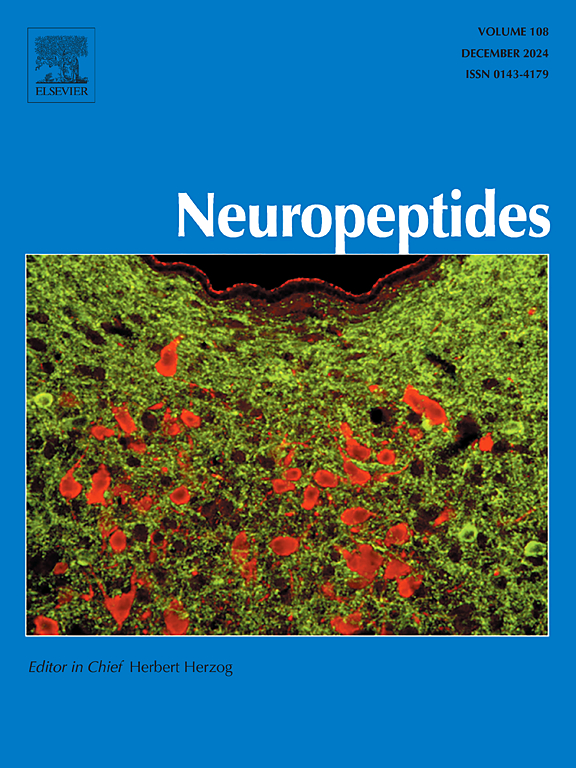Phoenixin-14 inhibits the formation of cerebral aneurysms in rats by downregulating the p38/NF-κB signaling pathway
IF 2.7
3区 医学
Q3 ENDOCRINOLOGY & METABOLISM
引用次数: 0
Abstract
Cerebral aneurysms (CA) are a serious condition characterized by the bulging of a blood vessel in the brain, which can lead to rupture and life-threatening bleeding. The pathophysiology of CA involves complex processes, particularly inflammation and macrophage infiltration. Phoenixin-14 (PNX-14) is a neuropeptide with diverse biological effects, including roles in reproduction, energy homeostasis, and inflammation. Recent evidence has highlighted the therapeutic potential of PNX-14 in various conditions. Notably, PNX-14 has demonstrated neuroprotective effects in the central nervous system, and we hypothesized that it could also offer vascular protection in the context of CA. In this study, we demonstrate that serum PNX-14 levels are reduced in patients and rat models with CA compared to healthy controls. Our findings show that PNX-14 administration significantly reduces aneurysmal size in a rat model with left renal artery ligation. Furthermore, PNX-14 mitigates the inflammatory response by inhibiting the expression of IL-1β and MCP-1 at both the mRNA and protein levels in the Circle of Willis (COW) region. PNX-14 treatment also decreases the levels of MMP-2 and MMP-9 in the COW region. Mechanistically, PNX-14 suppresses macrophage infiltration and inhibits the activation of the p38/NF-κB signaling pathway. These findings suggest that PNX-14 could be a promising therapeutic agent for the prevention and treatment of CA.
凤凰素14通过下调p38/NF-κB信号通路抑制大鼠脑动脉瘤的形成。
脑动脉瘤(CA)是一种严重的疾病,其特征是大脑血管膨胀,可能导致破裂和危及生命的出血。CA的病理生理过程复杂,尤其是炎症和巨噬细胞浸润。Phoenixin-14 (PNX-14)是一种具有多种生物学作用的神经肽,包括生殖、能量稳态和炎症。最近的证据强调了PNX-14在各种情况下的治疗潜力。值得注意的是,PNX-14在中枢神经系统中显示出神经保护作用,我们假设它也可以在CA的情况下提供血管保护。在本研究中,我们证明与健康对照组相比,CA患者和大鼠模型的血清PNX-14水平降低。我们的研究结果表明,PNX-14给药可显著减少左肾动脉结扎大鼠模型的动脉瘤大小。此外,PNX-14通过抑制威利斯圈(COW)区mRNA和蛋白水平上IL-1β和MCP-1的表达来减轻炎症反应。PNX-14处理也降低了奶牛区MMP-2和MMP-9的水平。机制上,PNX-14抑制巨噬细胞浸润,抑制p38/NF-κB信号通路的激活。这些结果提示PNX-14可能是一种很有前景的预防和治疗CA的药物。
本文章由计算机程序翻译,如有差异,请以英文原文为准。
求助全文
约1分钟内获得全文
求助全文
来源期刊

Neuropeptides
医学-内分泌学与代谢
CiteScore
5.40
自引率
6.90%
发文量
55
审稿时长
>12 weeks
期刊介绍:
The aim of Neuropeptides is the rapid publication of original research and review articles, dealing with the structure, distribution, actions and functions of peptides in the central and peripheral nervous systems. The explosion of research activity in this field has led to the identification of numerous naturally occurring endogenous peptides which act as neurotransmitters, neuromodulators, or trophic factors, to mediate nervous system functions. Increasing numbers of non-peptide ligands of neuropeptide receptors have been developed, which act as agonists or antagonists in peptidergic systems.
The journal provides a unique opportunity of integrating the many disciplines involved in all neuropeptide research. The journal publishes articles on all aspects of the neuropeptide field, with particular emphasis on gene regulation of peptide expression, peptide receptor subtypes, transgenic and knockout mice with mutations in genes for neuropeptides and peptide receptors, neuroanatomy, physiology, behaviour, neurotrophic factors, preclinical drug evaluation, clinical studies, and clinical trials.
 求助内容:
求助内容: 应助结果提醒方式:
应助结果提醒方式:


